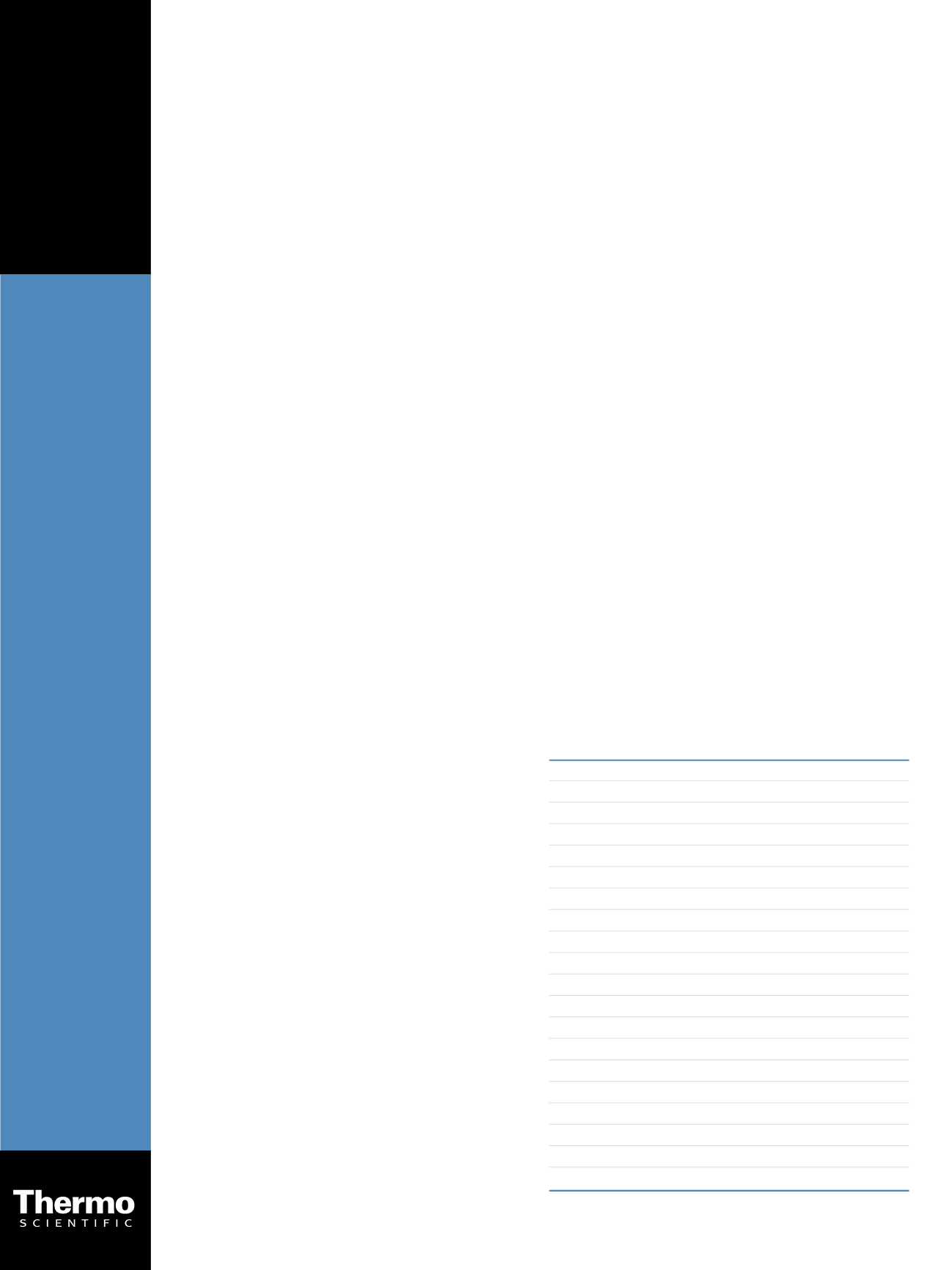

A Rapid Solution for Screening and Quantitating
Targeted and Non-Targeted Pesticides in Water
using the Exactive Orbitrap LC/MS
Olaf Scheibner
1
, Maciej Bromirski
1
, Nick Duczak
2
, Tina Hemenway
2
1
Thermo Fisher Scientific, Bremen, Germany;
2
Thermo Fisher Scientific, San Jose, CA, USA
Introduction
Within the field of environmental analysis, the demand
for quick and simple techniques to analyze large numbers
of samples is growing each year. While the limits of
quantitation (LOQs) required by governmental authorities
are lowered almost yearly, the number of analytes of
interest is growing exponentially. By using high-resolution,
accurate mass (HRAM) liquid chromatography-mass
spectrometry (LC-MS) (at least 50,000 resolution) and
full-scan experiments, compound identification, screening
and quantitation for an unlimited number of compounds
in a targeted or non-targeted screening approach can be
accomplished with only one chromatographic run.
A very simple, easy-to-reproduce screening and
quantitation method to identify pesticides in surface
water, ground water, and drinking water is presented here.
All samples were analyzed by using online solid phase
extraction (SPE) coupled to a Thermo Scientific Exactive
high performance benchtop mass spectrometer. The
acquired HRAM data was processed by using Thermo
Scientific ExactFinder software for unified qualitative and
quantitative data processing. All targeted pesticides in
the entire mixture were identified, and a number of
non-targeted pesticides were found and confirmed by
elemental composition. In the same workflow, all samples
underwent quantitative analysis.
Goal
To demonstrate a screening and quantitation method for
pesticides in water developed for the Thermo Scientific
EQuan MAX system utilizing ExactFinder™ software
to process the HRAM data.
Experimental
Sample Preparation
A variety of water samples, including surface water,
ground water, and drinking water, were spiked with
20 pesticides (Table 1) at different levels. The pesticide
mixture consisted of very nonpolar analytes together
with very polar metabolites, representing the full range
of polarity characteristics, apart from ionic compounds,
normally found in environmental analyses. A dilution
series of the same pesticide mixture was provided in
ultrapure water at six different levels for calculation
of a calibration curve.
HPLC
All samples were injected onto the EQuan MAX
automated high throughput LC-MS system without
further treatment (Figure 1). The EQuan MAX system
offers online-SPE for preconcentration of samples up to
20 mL. By using the EQuan MAX system, the analysis
of compounds in the ng/L or even lower concentrations
are possible, saving time and capital by automation of
the extraction and preconcentration process. To achieve
a reliable extraction of all nonpolar analytes and polar
metabolites in one run, two extraction columns with
different polarity characteristics were coupled. A nonpolar
column with C18 selectivity (Thermo Scientific Hypersil
GOLD 20 x 2.1 mm, 12 µm particle size) was placed
upstream of a very polar column (Thermo Scientific
Hypercarb 10 x 2.1 mm, 5 µm particle size). Elution of
the trapped analytes and the transfer to the analytical
column (Hypersil
TM
GOLD PFP 100 x 2.1 mm, 1.9 µm
particle size) were carried out in backflush mode to prevent
retention of the nonpolar compounds trapped on the C18
column through contact with the Hypercarb™ material.
The injection volume for all samples was 1000 µL.
Application
Note: 535
Key Words
• EQuan MAX
• Exactive
• ExactFinder
• Pesticide
screening
• Water analysis
Table 1. Pesticides and their metabolites spiked into water samples
Compound Name
Elemental Composition
Alachlor
C
14
H
20
NO
2
Cl
Atrazine
C
8
H
14
N
5
Cl
Atrazine Desethyl-
C
6
H
10
N
5
Cl
Atrazine Desisopropyl-
C
5
H
8
N
5
Cl
Carbamazepine
C
15
H
12
N
2
O
Chloridazon
C
10
H
8
N
3
OCl
Chloridazon Desphenyl-
C
4
H
4
N
3
OCl
Chloridazon Methyl-desphenyl-
C
5
H
6
N
3
OCl
Chlortoluron
C
10
H
13
N
2
OCl
Diuron
C
9
H
10
N
2
OCl
2
Isoproturon
C
12
H
18
N
2
O
Lenacil
C
13
H
18
N
2
O
2
Metalaxyl
C1
5
H
21
NO
4
Metamitron
C
10
H
10
N
4
O
Metazachlor
C
14
H
16
N
3
OCl
Metolachlor
C
15
H
22
NO
2
Cl
Metribuzin
C
8
H
14
N
4
OS
Quinoxyfen
C1
5
H
8
NOCl
2
F
Simazine
C
7
H
12
N
5
Cl
Terbuthylazine
C
9
H
16
N
5
Cl



















